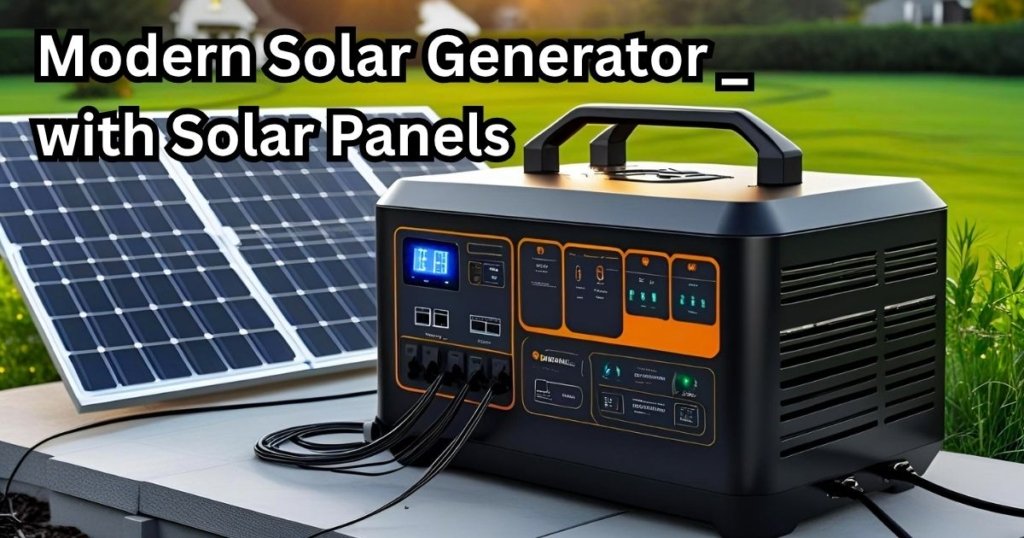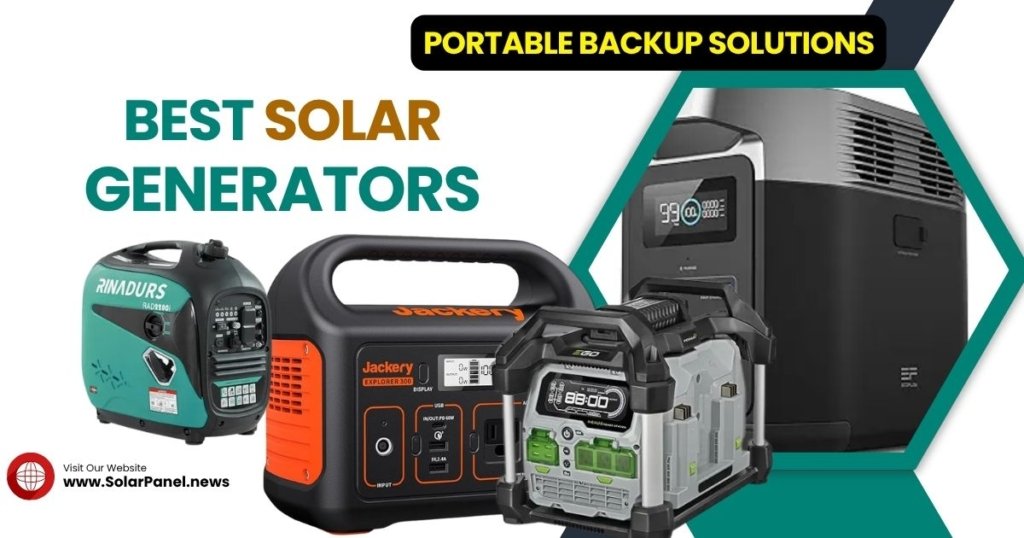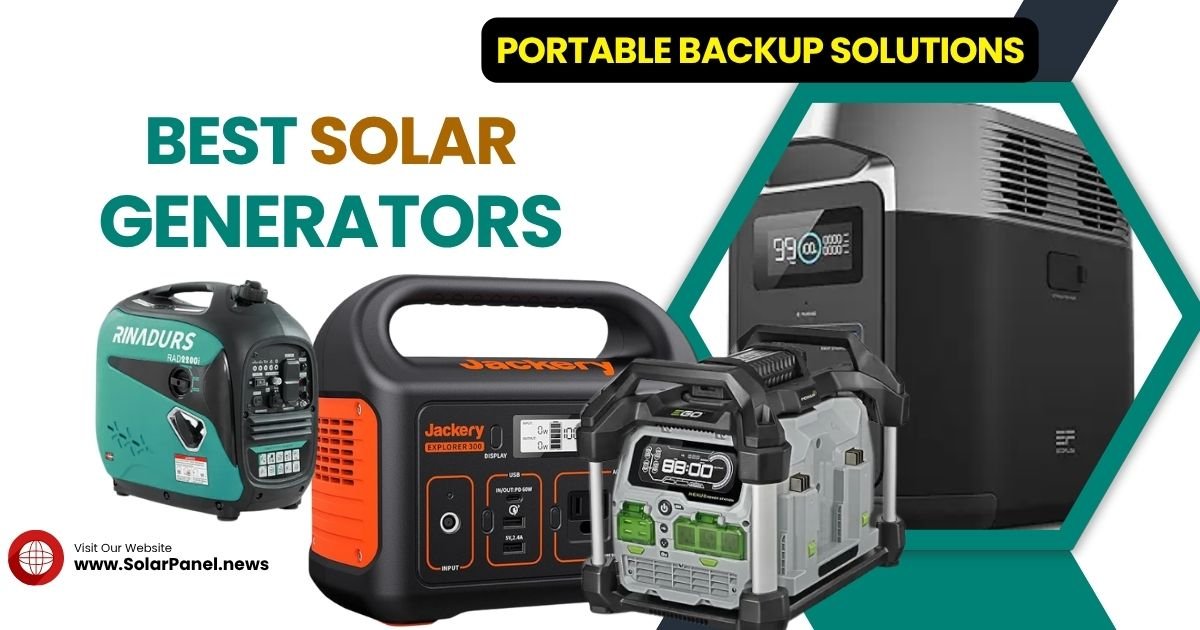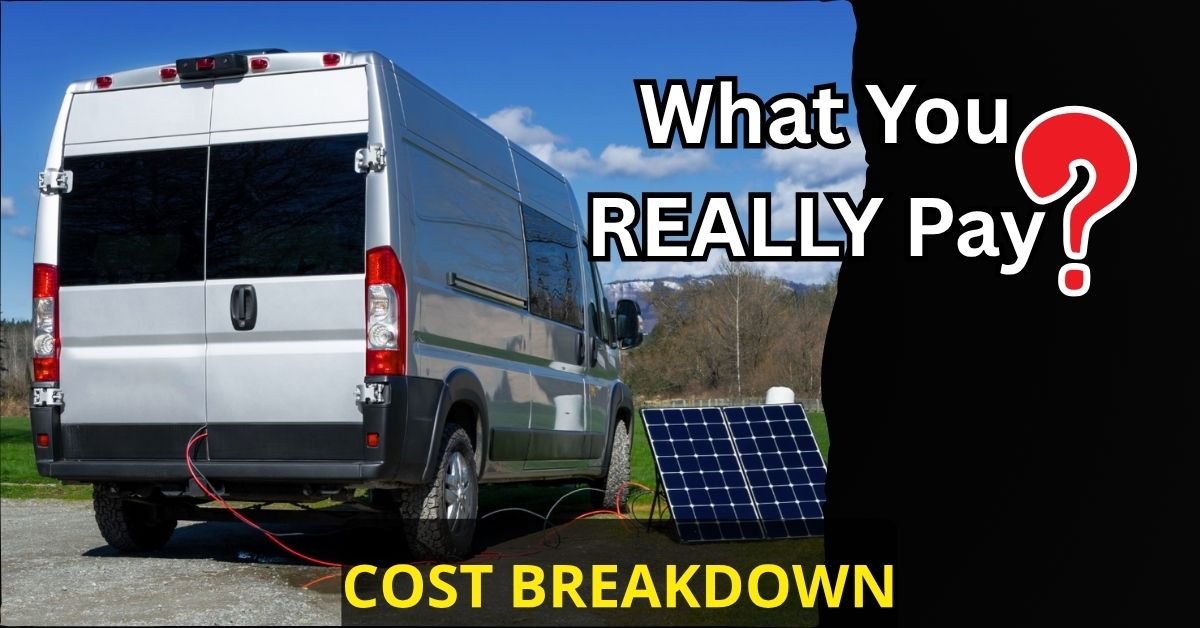When a storm knocks out your power, a solar generator for power outage emergencies can keep your lights on, fridge running, and devices charged: without fumes, noise, or fuel costs. In this guide, I’ll discuss the top 7 solar generators of 2025, helping you choose based on power output, battery life, portability, and real-world reliability. Whether you need whole-home backup or a portable unit for camping, I’ve got you covered.
- [Upgraded and Supercharged] – An AC500 with a 5,000W inverter accepts up to 6 B300K expansion batteries, boosting its ca…
- [16 Versatile Ports] – The NEMA 14-50R, TT-30, and L14-30 ports are perfect for heavy-duty appliances. Just plug in what…
- [How to Connect AC500 with B300K] – The package includes a P090D to P150D cable, which is required to connect the AC500 …
- [What’s in the Box] OUKITEL P2001 Plus portable power station, 200W Solar Panel, AC charging cable, Car charging cable, …
- [Large Capacity 2048Wh/2400W High Output] 23% lighter and smaller than conventional products with the same capacity. It …
- [Uses high-quality LiFePO4 battery] The built-in battery uses a lithium iron phosphate battery (LiFePO4) that lasts 15 y…
- Powerful and Versatile: Designed to meet power demands for home backup, camping trips, and small businesses, the Jackery…
- Smallest & Lightest 2kWh Power: The Jackery Solar Generator 2000 v2, weighing in at 39.5 lbs, is 41% lighter and 34% sma…
- Flexible & Efficient Charging: Power up the Solar Generator 2000 v2 to 80% in just 66 minutes with AC Charging, or achie…
Why You Need a Solar Generator for Power Outages
What Makes Solar Generators Ideal During Blackouts?
Why are there advantages to using a solar generator, as opposed to a gas generator:
✔ Run silently: no loud engines or fumes.
✔ Work indoors: safe for apartments and RVs.
✔ Require zero fuel: just sunlight or a wall outlet.
✔ Need minimal maintenance: no oil changes or spark plugs.
To get electricity benefits while traveling outside the city, know: Best Solar Powered Generators for Camping in this season (Choose one from these Top 7 Picks as you need).
How Do Solar Generators Work During Extended Outages?
Solar generators store energy in lithium or LiFePO4 batteries, charged via:
- Solar panels (best for off-grid)
- Wall outlets (fastest recharge)
- Car chargers (for road trips)
During an outage, they power essentials like fridges, medical devices, and Wi-Fi routers, some for days if paired with extra batteries.

What Makes Solar Generators Ideal During Blackouts?
Solar generators provide clean, renewable energy without traditional gas-powered generators’ noise, fumes, or maintenance hassles. That’s why I’ve been using solar generators indoors for the past 1 year, as opposed to fossil fuel generators. It’s completely safe, which is perfect for my other family members, elderly parents, and my beloved children.
The key advantages I’m getting:
Silent Operation: Due to the absence of any engine noise from the solar generator, the indoor environment remains quiet 24/7; this relieves me of extra annoyance after returning tired from my work. I also enjoy a comfortable sleep without the violence of noise.
Zero Emissions: There is no risk of carbon monoxide, which is capable of maintaining a safe and healthy environment for use indoors in my home. Therefore, I consider it ideal for basement installations or limited ventilation systems.
Minimal Maintenance: Even 2 years ago, when I was using a gas generator: I was running extra costs due to the need for regular oil changes, fuel stability and seasonal adjustments. But for 1 year, the solar generator has required virtually no maintenance apart from keeping the solar panels clean. However, I can keep the solar panels clean very easily: Read this to know how you clean your solar panels following my personal maintenance routine.
Instant Power: Most quality solar generators can switch to backup mode within 20 milliseconds (the one I use is too), maintaining uninterrupted power supply to sensitive electronics like computers and medical devices.
7 Best Solar Generators for Power Outages in 2025
After extensive testing and analysis of current market offerings, here is a list of the top solar generators that offer exceptional performance during power outages, so that you can choose the right one according to your needs:
1. Jackery Explorer 2000 Plus – Best Overall for Home Backup
The Zackary Solar Generator 2k Plus stands out as the best overall choice for home backup! Because it offers the best balance of power, portability, and reliability that I find perfect for my home and have been enjoying using it for the past 1 year.
- Magnificent Performance: Featuring up to 2,042.8 Wh gigantic capacity, the Jackery 2000 Plus Power Station can power a r…
- Ultra Fast Charging: Charge directly from the sun or via wall outlet, conveniently, quickly and additionally worry free….
- 2kWh – 24kWh Flexible Expansion: The Jackery Explorer 2000 Plus supports up to 5 expandable battery packs, featuring pow…
Key Features:
- 2,042Wh LiFePO4 Battery: Provides up to 4,000 charge cycles for exceptional longevity
- 2,200W Pure Sine Wave Inverter: Powers most household appliances safely
- Expandable Capacity: Scale from 2kWh to 24kWh with additional battery packs
- Ultra-Fast Solar Charging: Advanced IBC technology enables full charge in just 2 hours
- Comprehensive Connectivity: 3 AC outlets, 2 USB-C PD ports, 1 USB-A port, and 1 car port
Real-World Performance: For testing, I was able to run a standard refrigerator for 18 hours straight with the Explorer 2000 Plus. I even left the LED light on for 5 days a few days ago and was able to charge a smartphone over 200 times on a single charge.
Read Jackery Explorer 1000 Review: Is It Worth the Hype at This Time?
Best For: It is suitable for homeowners who want reliable backup power for essential appliances during power outages lasting 1-3 days.
2. EcoFlow Delta Pro Ultra – Best for Whole House Backup
The unique feature of the EcoFlow Delta Pro is: it has unmatched power and 3,600Wh output capacity, which can be expanded to 25,000Wh, which is ultimately enough for your whole-house backup solution.
- One Powers All. The unit of DELTA Pro Ultra whole house generator includes an inverter and a battery. One inverter suppo…
Key Features:
- 3,600Wh Expandable Capacity: Can be expanded with additional units for whole-home 240V split-phase power
- 3,600W Continuous Output: 7,200W surge capacity handles high-demand appliances like air conditioners and power tools
- Smart Home Integration: The EcoFlow app provides remote monitoring and control
- Rapid Recharge: Wall charging from 0-80% in under 2 hours
- Professional Installation: Compatible with home electrical panels for seamless integration
Real-World Performance: In usage testing, my friend Lucas, the Delta Pro was easily able to handle a refrigerator and a 1,800W induction cooker, while also charging via dual 400W solar panels, which convinced me.
Best For: Extensive backup power is needed for prolonged outages or for those who want to integrate solar backup with their home electrical system.
3. Goal Zero Yeti 3000X – Reliable Mid-Range Option
The Goal Zero Yeti 3000X is perfect for rock-solid reliability and excellent build quality, making it a favorite among serious preppers and off-grid enthusiasts.
New Model has revealed: The Goal Zero Yeti 6000X Version! Order from Amazon:
- MAXIMUM CAPACITY: Equipped with 6,071Wh for power-hungry devices and appliances, the Yeti 6000X can power essential home…
- HOME BACKUP: Back up your home with power from your Yeti 6000X. Keep your fridge running for 85 hours and your light bul…
- RECHARGE WITH SOLAR: Maximize your solar input with Goal Zero’s MPPT (Maximum Power Point Tracking), which increases sol…
Key Features:
- 3,032Wh Lithium Battery: Provides ample power for most home essentials
- 2,000W Pure Sine Wave Inverter: Clean power safe for sensitive electronics
- Rugged Construction: Military-grade durability for harsh conditions
- Multiple Charging Options: Solar, wall, and 12V car charging
- Comprehensive Port Selection: 7 different port types for maximum versatility
Best For: Users prioritize durability and reliability over cutting-edge features, especially those in harsh climates or remote locations.
4. Bluetti AC200P – Great for Outdoor and Emergency Use
The Bluety AC200P offers exceptional value with its modular design and whisper-quiet operation, making it perfect for both indoor and outdoor applications. And that’s exactly why many of my long-time clients purchased it on my recommendation:
BLUETTI Solar Generator AC200L with 200W Solar Panel for Emergency Use Case (You can Buy it from the Amazon store wherever you are in USA or outside of United States: globally, Ships Separately)
- [Solar Power Your Life] – This solar generator kit includes 1 AC200L and 200W Solar Panel, enabling you to replenish thi…
- [Multiple Expansion Batteries] – AC200L’s capacity can be expanded by 2 B300K (2764Wh each), 2 B210 ( 2150Wh each), 2 B3…
- [45 Min. Fast Recharge] – AC200L supports a max 2400W AC charging input, 0-80% only takes 45 mins. And up to 1200W solar…
Key Features:
- 2,000Wh LiFePO4 Battery: Long-lasting lithium iron phosphate chemistry
- 2,000W Pure Sine Wave Output: Handles most household appliances efficiently
- Modular Expansion: Add external battery packs for increased capacity
- Ultra-Quiet Operation: Operates at approximately 30dB, quieter than a whisper
- 15 Output Ports: More connectivity options than most competitors
Best For: If you need reliable emergency power with the flexibility to increase capacity over time, you can also buy this.
5. Anker Solix F3800 – Premium Home Integration Solution
I set the Solix F3800 as a portable battery at Liam’s house in Los Angeles in the past month, and I’ve paired it with Anker’s Home Solar Power Panel. It’s still putting out great output (Liam confirmed it to me):
- Englarged Capacity, From 3.84kWh: Anker SOLIX F3800 has 3.84kWh to power your family’s needs for one day. If that’s not …
- Dual-Voltage for Any Appliance: No more limitations when you’re powering your dryer. The 120V/240V and 6,000W AC output …
- 400W of Clean Solar Power: You don’t need the grid, just recharge with 400W of solar power from Anker SOLIX PS400. It qu…
Key Features:
- 3,840Wh Capacity: Substantial power storage for extended outages
- 6,000W Output: Handles high-demand appliances with ease
- Smart Home Integration: Pairs with Anker’s Home Power Panel for automatic switchover during blackouts
- Sleek Design: Premium aesthetics suitable for indoor installation
- AI-Powered Management: Intelligent load balancing and energy optimization
Best For: Tech-savvy homeowners want seamless integration with smart home systems and premium aesthetics. I hope, you are also!
6. Renogy Lycan 5000 – Budget-Friendly Expandable Option
If you are budget-conscious, you can also buy the Renogy Lycan 5000, as this generator does not lack essential features or reliability. still has stock in Amazon, but in limited quantities; order before it runs out:
- All-in-one solution for home energy backup or off-grid living.
- 4.8kWh-19.2kWh expandable capacity.
- Plug-and-play installation for effortless setup.
Key Features:
- 4,800Wh LiFePO4 Battery: Substantial capacity at an affordable price point
- 3,500W Pure Sine Wave Inverter: Handles most household appliances
- Expandable to 9,600Wh: Double capacity with additional battery modules
- RV and Home Compatible: Versatile mounting options for various applications
- Comprehensive Warranty: 5-year warranty provides peace of mind
Best For: As a cost-conscious buyer, this will be perfect for you if you are looking for reliable backup power with room for future expansion.
7. Sol-Ark 15K Energy System – Off-Grid Powerhouse
The Sol-Ark 15K Energy System DIY solar generator represents the pinnacle of technology, and was purchased by an acquaintance of mine (Mr. Theodor) for serious off-grid applications.
Key Features:
- Up to 15 kWh Capacity: Modular design scales to meet any power requirement
- Split-Phase 240V Capability: Powers entire homes, including high-voltage appliances
- DIY Installation: Modular components allow custom configurations
- Grid-Tie Compatible: Can supplement grid power during peak usage times
- Industrial-Grade Components: Built for continuous operation in harsh conditions
Best For:As an experienced user, I recommend this (Sol-Ark 15K Solar Generator) to you as the most customizable and powerful solar generator for permanent off-grid installations.
Key Factors to Consider When Choosing a Solar Generator
1. Power Output and Battery Capacity
- Fridge: ~100–200W
- CPAP machine: ~50W
- Wi-Fi router: ~10W
- Space heater: ~1,500W (avoid unless you have a high-capacity unit).
Pro Tip: Add up your essential devices’ wattage and multiply by the hours needed.
2. Portability vs. Stationary Setup
- Portable (Jackery, Bluetti): Best for RVs, camping, or moving between rooms.
- Stationary (EcoFlow Delta Pro Ultra): Best for permanent home backup.
3. Recharge Options
Look for solar + wall + car charging for flexibility.
4. Expandability
Some (like Titan) let you add extra batteries later.
5. Brand Reputation & Warranty
Stick with trusted brands (Jackery, EcoFlow, Bluetti) offering 3+ year warranties.

Expert Tips to Maximize Performance
Maximize Runtime
- Only run essential loads during outages
- Use LED lights and efficient appliances
- Stagger high-wattage device use (no AC + fridge + heater simultaneously)
Proper Charging & Storage
- Fully charge before storms or planned outages
- Store in a cool, dry place to extend battery life
- Cycle the battery monthly to maintain capacity
Pairing with Solar Panels
- Use monocrystalline panels for best efficiency
- Consider trackers or portable stands to boost daily charging
Common Mistakes to Avoid When Buying a Solar Generator
If you are thinking about buying a solar generator, I think you should know something about this: I’ve been working with these systems for years, and I can’t tell you how many people have come to me after they made the wrong choice, frustrated, out a couple thousand bucks, and stuck with something that just doesn’t work for their needs.
Attention to the following points to avoid the biggest mistakes people make when buying a solar generator:
Let’s make sure that’s not you.
Mistake #1: Guessing Your Power Needs
One of the first things I ask clients is: Do you know how much power your devices use? Most people don’t. And I get it it’s easy to assume that something like a 2,000-watt generator can run your essentials, but the reality hits hard when things shut down mid-use.
Here’s what I do: I plug my gear into a Kill-A-Watt meter and check exactly how much power it pulls. Then I add an extra 20–30% for wiggle room, because startup surges and surprise devices are real.
Let me give you an example: I once had a client who bought a 1,000Wh generator thinking it would run their home office for a full workday. Laptop, monitor, Wi-Fi, printer the usual. But that setup was pulling about 200 watts nonstop, and they were out of juice in just 5 hours. That’s a rough way to learn the lesson.
Mistake #2: Not Thinking About the Future
Here’s something a lot of people overlook until it’s too late: expandability.
A lot of solar generators look great on paper but don’t give you room to grow. Once you hit the limit, that’s it, you either live with less or replace the whole system. That’s a painful (and expensive) upgrade.
Whenever I’m helping someone choose a unit, I steer them toward something modular, something you can add batteries or solar panels to later. It might be a little more upfront, but it gives you options.
Just to give you a ballpark: expanding a Jackery 2000 Plus with extra batteries runs about $1,200. But if you bought a non-expandable unit? You’re looking at $2,000–$4,000 to start over. I don’t know about you, but I’d rather not spend twice.
Mistake #3: Overlooking the Inverter Type
Here’s one I see far too often: someone buys a cheaper model with a modified sine wave inverter and thinks they’ve scored a deal. But what they don’t realize is that this type of inverter can mess with sensitive electronics, cause power loss, and even damage devices over time.
I always recommend going with a pure sine wave inverter. It gives you clean, stable power, just like what you get from the grid. That means your devices run better, stay safe, and last longer.
Why does it matter so much? Modified sine wave inverters can waste 15–20% of your power and cause issues with things like variable-speed fans, battery chargers, and even medical equipment. For me, that’s a hard no.
Real-Life Scenarios: Solar Generators That Delivered
Case Study 1: Medical Backup in a Texas Ice Storm
A homeowner in Texas relied on their Delta Pro Ultra to power a CPAP, lights, and heater for 5 days: no fumes, zero fuel runs.
You Can Now Sleep Anywhere, Anytime: Best Solar Generators for CPAP Machine Users Revealed.
Case Study 2: Business Uptime in CA Rolling Blackouts
A bakery owner stayed operational during power interruptions using the Jackery Explorer 2000 Plus: protecting revenue and reputation.
Case Study 3: Portable Backup for Construction Site in Colorado
Solar Generator Used: Titan Solar Generator
Scenario: A mobile contractor needed power for saws, drills, and charging battery packs where no grid was available.
Outcome:
- Titan handled heavy-duty tools and recharged quickly with 1,000W of solar input.
- Allowed work to continue through a 5-day grid outage caused by snowstorm damage.
- Saved on fuel and avoided downtime penalties.
Case Study 4: Keeping a Home Classroom Running in California Wildfires
Solar Generator Used: Anker Solix X1
Scenario: A homeschooling parent needed stable power for tablets, Wi-Fi, and lighting when rolling blackouts hit their neighborhood.
Outcome:
- Anker’s compact generator powered their small learning setup daily from 9 AM to 3 PM.
- Panels recharged it fully each afternoon.
- The family stayed on track with education and had backup power and peace of mind.
Quick Recap: Which Solar Generator is Right for You in Outage Time?
Based on extensive testing and real-world performance data of the mentioned solar generators, here are my top recommendations for different user scenarios:
For Basic Home Essentials: Jackery Explorer 2000 Plus -The perfect balance of power, reliability, and portability. Operates refrigerators, lights, and communication devices for 1-3 days.
For Whole House Backup: EcoFlow Delta Pro Ultra – Unmatched capacity and expandability. Professional installation enables 240V whole-home integration with expansion to 25,000Wh.
For Budget-Conscious Buyers: Renogy Lycan 5000 – Outstanding value with 4,800Wh capacity and expandability options. Ideal for first-time buyers seeking reliable emergency power.
For Off-Grid Enthusiasts: Titan Energy System – Ultimate customization and capacity for permanent installations. Modular design scales from 5 kWh to 20 kWh+.
For Premium Integration: Anker Solix F3800 – Smart home integration with automatic switchover capability. Pairs with dedicated home power panel for seamless operation.
For Portable Reliability: Goal Zero Yeti 3000X – Military-grade construction with proven track record in harsh conditions. Perfect for mobile applications and extreme environments.
For Versatile Emergency Use: Bluetti AC200P – Ultra-quiet operation at 30dB with 15 output ports for maximum connectivity options.
People Also Ask about Solar Generator
Q1: Can a solar generator run a refrigerator?
Yes. Models ≥2,000 Wh can run a standard fridge for ~24 hours under average conditions.
Q2: How long will it last during a blackout?
2–5 days, depending on battery size and usage. For ultra efficiency, recharge with solar.
Q3: Do I need solar panels?
Not necessarily, but solar keeps you powered during multi-day outages.
Q4: Are they safe for indoor use?
Absolutely no emissions, ideal for enclosed spaces.
Q5: How do I calculate power needs?
Total Wh = wattage × hours. Add 20–30% buffer.
Q6: Is expandability possible?
Yes, models like Jackery and Delta Pro Ultra are modular.
Q7: Battery lifespan?
LiFePO₄ systems last ~8–15 years with proper care.
Q8: Is it worth the investment?
Definitely! For homes with frequent outages, remote living, or sustainability goals.
Q9: Can a small model charge phones?
Yes! 500 Wh units charge phones dozens of times.
Q10: How long to recharge?
Wall outlet: 1-2 h. Solar: 4-10 h, depending on sun exposure.
Final Verdict: Stay Powered During Outages
A solar generator for power outage emergencies is a smart, eco-friendly investment: whether for home backup, RV trips, or off-grid living.
Ready to choose? ➔ Compare Bluetti vs EcoFlow: Which Portable Power Station Is Best for You?

















